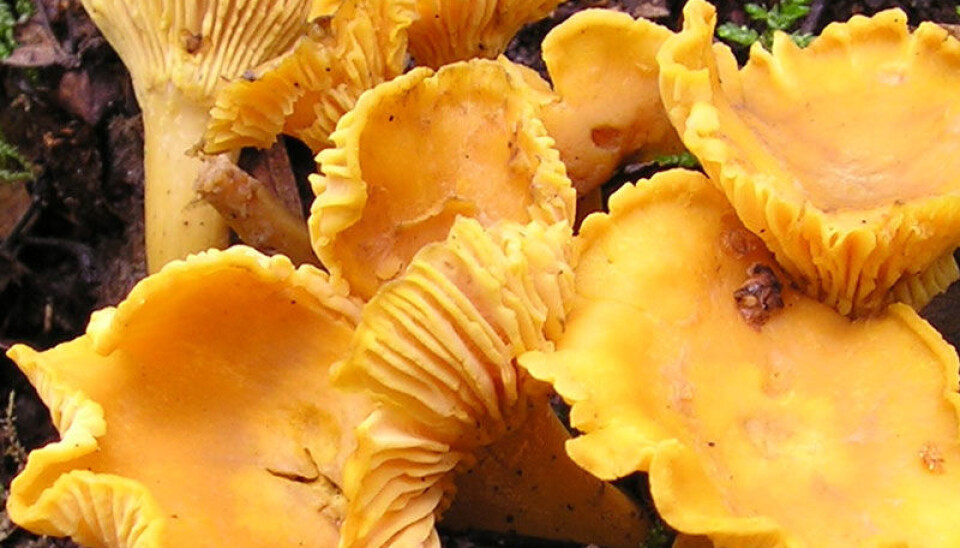
Warmer climate prolongs mushroom season
The wild mushroom season has grown longer the last 40 years in Norway and elsewhere in Europe. More chanterelles, certainly, but the changes can be challenging.
Denne artikkelen er over ti år gammel og kan inneholde utdatert informasjon.
Researchers from the University of Oslo (UiO) and the Norwegian Forest and Landscape Institute have studied how the mushroom season has varied in the past four decades.
Together with European colleagues, they have analysed data from Norway, Great Britain, Austria and Switzerland from 1970 to 2007 and found a clear tendency: the mushroom season starts later and lasts longer.
Extensive survey
The researchers have studied the most common cap mushrooms in each country, a total of nearly 750,000 individual fungi. They’ve looked at when the mushroom season starts, peaks and ends.
Their results have been published in the journal Proceedings of the National Academy of Sciences (PNAS).

“In all four of the countries we studied, the autumn mushroom season has been prolonged. It starts a little earlier and ends a little later,” says Assistant Professor Håvard Kauserud of the UiO’s Department of Biology.
Ways in which the mushroom season have been altered vary from country to country and among different mushroom groups.
According to Kauserud, mushrooms that decompose dead organic matter, known as saprotrophic fungi, have a longer season than species living in symbiosis with plant roots. These are designated as mycorrhizal fungi, which include such delicacies as chanterelles and porcini.
Researchers observe a general trend toward longer and later mushroom seasons.
“In all four countries the average fruiting period has shifted to a little later. This means the main peak of the mushroom season comes a little later than before and the season is prolonged,” says the researcher.
Effects of climate changes
The changes are particularly dramatic in the United Kingdom, where the mushroom season has been radically extended. According to the researchers, this is probably because the UK generally has a coastal climate, with mild winters and relatively cool summers. Scientists believe that climate changes are the probable cause of the extended mushroom season.
“We think this is an effect of climate changes, in other words a warmer climate. This is also manifested by the lengthening of the growth season for plants, which the mushrooms depend upon,” explains Kauserud.
“In many countries the mushroom season ends when the frosts and snow come. In all four of the countries, we see the first nights with frost are coming later in the autumn than they used to. This is probably a factor enabling the fruiting of the mushrooms to last longer.”
Good news and bad news
The fungi researchers’ findings are great for mushroom pickers:
“Our findings indicate the mushroom season is getting longer, which can be viewed as good news. The longer growth season possibly enables plants to supply their associated mushrooms with more carbohydrates so that more fruit bodies can sprout up,” says Kauserud.
However, a lengthened mushroom season isn’t necessarily without problems. Fungi are integral to many ecosystems and they are essential in decomposing dead material. A later and longer mushroom season can thus have consequences for the ecosystems we depend on for life.
The mycologists think changes in the active seasons for mushrooms can impact the carbon and CO2 balance on the planet. But the question is how?
“More favourable climatic conditions for decomposers would in theory lead to a faster terrestrian carbon cycle and increased natural emissions of CO2. Favourable conditions for mycorrhizal mushrooms would increase metabolism among host plants, generating more photosynthesis. So more carbon would be organically trapped – in other words less CO2,” says Kauserud.
“Mycorrhizal fungi can also decompose dead organic matter and contribute to a faster cycle of nutrients and increased quantities of CO2. So here are two effects that pull in opposite directions when it comes to greater or lesser quantities of CO2. We don’t know enough yet about the total effects.”
------------------------------
Read the Norwegian version of this article at forskning.no
Translated by: Glenn Ostling
































